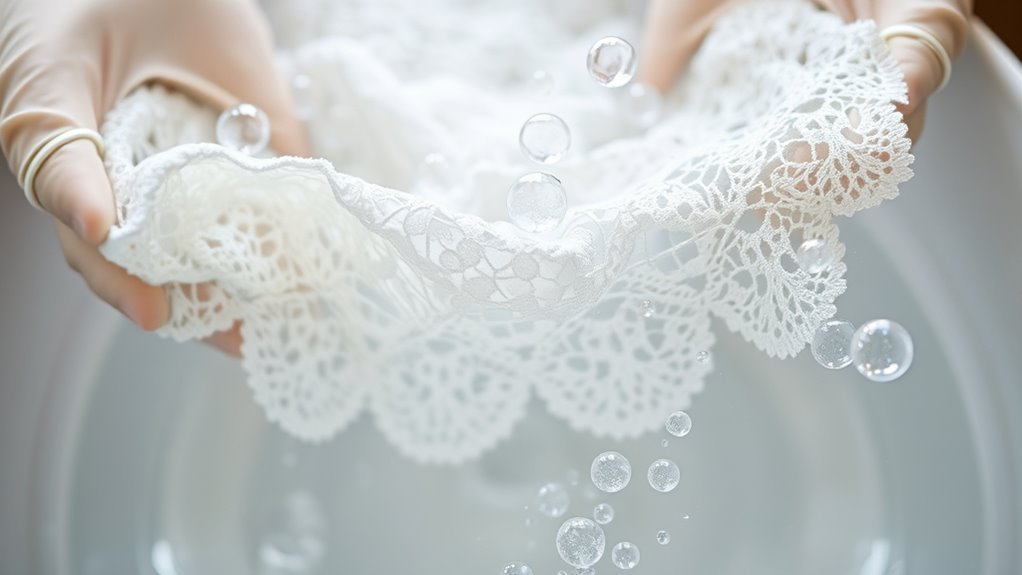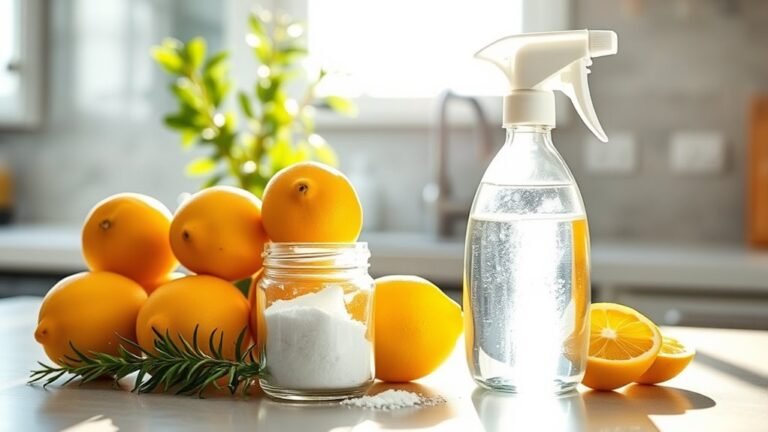Washing Germs Without Damage
You can keep your clothes germ-free without damage by using gentle, germ-fighting detergents and washing in warm water around 104°F (40°C). Avoid harsh chemicals and high heat to protect fabric fibers. Add vinegar or baking soda carefully, and try steam disinfection for a chemical-free deep clean. Proper drying—like tumble drying with heat or air drying in ventilation—helps kill lingering germs. Want to find out how to balance cleanliness with fabric care for lasting freshness?
Understanding Germs on Clothing

Although you might not see them, germs can easily cling to your clothes throughout the day. Different germ types—bacteria, viruses, and fungi—interact uniquely with various fabrics, influencing how stubborn they become. Some germs latch more firmly onto rough textures like denim, while smoother fabrics like silk might hold fewer microbes but still aren’t immune. Understanding this fabric interaction helps you realize why your clothes can carry unseen risks and why regular washing is essential. You deserve the freedom to wear what you want without worry, knowing that the germs hitching a ride on your clothes won’t compromise your health. Recognizing how germs behave on fabric empowers you to take control of your cleanliness without sacrificing your style or lifestyle choices.
Choosing Gentle Detergents That Fight Germs
How can you effectively remove germs from your clothes without harsh chemicals? You can choose gentle detergents that still fight germs while respecting your skin and the planet. Look for eco friendly options that minimize environmental impact but don’t sacrifice cleanliness. Hypoallergenic choices are ideal if you want to avoid irritation and stay free from unnecessary additives.
Consider these tips:
- Pick detergents labeled as both germ-fighting and gentle on fabrics.
- Opt for plant-based ingredients that naturally combat bacteria.
- Avoid fragrances or dyes that might trigger allergies.
- Check for certifications ensuring safety and eco friendliness.
The Role of Water Temperature in Germ Removal

You might think hotter water always means cleaner clothes, but finding the ideal temperature is key to killing germs without harming your fabrics. Too high a temperature can weaken fibers, while too low might not eliminate bacteria effectively. Let’s explore how to balance temperature for both cleanliness and garment care.
Optimal Water Temperature
When you wash your hands or clothes, the water temperature plays an essential role in killing germs effectively. Finding the ideal washing temperature isn’t just about heat—it’s about balance and following clear temperature guidelines to maximize germ removal without harming your skin or fabrics.
Here’s what to keep in mind:
- Warm water (around 104°F/40°C) works well for everyday washing, efficiently removing most germs.
- Hot water (130°F/54°C or higher) kills more bacteria but isn’t always necessary and can waste energy.
- Cold water saves energy but may require longer washing times or stronger detergents to be effective.
- Follow recommended temperature guidelines for specific items to guarantee both cleanliness and care.
Choosing the right temperature frees you to wash smartly and safely.
Temperature Effects on Fabrics
Although higher water temperatures can kill more germs, they can also weaken fabrics over time, so you’ll want to balance cleanliness with care. Understanding your fabric’s resilience and temperature tolerance is key to preserving your clothes while keeping them fresh. Some fabrics, like cotton, handle warmer water well, boosting germ removal without sacrificing durability. Others, such as wool or silk, have low temperature tolerance and may shrink or lose shape if washed too hot. By choosing the right temperature for each fabric type, you maintain both hygiene and fabric integrity. This way, you’re free to keep your wardrobe germ-free without unnecessary wear, enjoying both safety and longevity in your fabrics. It’s about smart washing, not just hot water.
How to Use Vinegar and Baking Soda Safely
You’ve probably heard that vinegar and baking soda are great natural cleaners, but using them safely is key. It’s important not to mix them directly, as their reaction can cause fizzing that’s best handled carefully. Let’s look at the basics, how to combine them safely, and the best ways to apply them for cleaning without damage.
Vinegar and Baking Soda Basics
Since vinegar and baking soda are common household items, you might think using them for cleaning is straightforward, but it’s important to handle them carefully to avoid damage. Both offer powerful benefits when used right: vinegar benefits include natural disinfecting and deodorizing, while baking soda applications range from gentle scrubbing to neutralizing odors. To use them safely:
- Always test vinegar on a small, hidden surface to prevent damage to delicate materials.
- Use baking soda sparingly on soft surfaces to avoid abrasions.
- Apply vinegar diluted with water for routine cleaning to protect finishes.
- Store both in airtight containers to maintain effectiveness and avoid moisture.
Safe Mixing Techniques
When mixing vinegar and baking soda, you’ll want to be cautious because their reaction creates carbon dioxide gas, which can cause fizzing or even overflow if not controlled. To enjoy safe fabric care without limiting your freedom, always add them separately during washing rather than mixing them directly. Avoid combining other detergents with vinegar and baking soda as well, since improper mixing can damage fabrics or reduce cleaning efficiency.
| Tip | Reason |
|---|---|
| Add separately | Prevents uncontrolled fizzing |
| Use moderate amounts | Avoid fabric damage |
| Avoid mixing with detergents | Prevents chemical reactions |
| Rinse well | Removes residue for better fabric care |
Proper Application Methods
Understanding how to apply vinegar and baking soda properly can make a big difference in your washing routine. To get the most out of these natural cleaners, follow these proper washing techniques for effective stain removal without damaging fabrics.
- Pre-treat stains by sprinkling baking soda directly on the spot, then spray vinegar gently to activate fizzing—wait 10 minutes before washing.
- Add half a cup of vinegar to your washing machine’s rinse cycle to soften clothes and remove odors.
- Use baking soda in the wash cycle to boost detergent power and lift grime.
- Avoid mixing vinegar and baking soda in a closed container to prevent pressure buildup.
Benefits of Using Steam for Disinfection
Although you might not realize it, using steam for disinfection offers a powerful way to kill germs without harsh chemicals. When you rely on steam sanitation, you tap into a natural, effective method that guarantees germ eradication without damaging surfaces or fabrics. This approach gives you the freedom to maintain a clean environment safely and sustainably. Steam penetrates deeply, reaching hidden bacteria that traditional cleaning might miss, so you can trust it to protect your space thoroughly. Plus, you don’t have to worry about harmful residues or chemical exposure, making it a smart choice for households seeking health and environmental balance. Embracing steam disinfection means you’re choosing a method that’s both efficient and gentle, empowering you to keep things fresh without compromise.
Washing Delicate Fabrics Without Compromise

If you want to keep your delicate fabrics looking their best, you need a washing method that’s both gentle and effective. Gentle washing guarantees your clothes stay vibrant and intact without sacrificing cleanliness. Here’s how you can achieve that balance:
- Use cold water to prevent shrinking and fading, preserving your fabric’s integrity.
- Choose mild detergents designed for delicate fabrics to maintain softness and avoid damage.
- Opt for the delicate or hand-wash cycle on your machine to reduce agitation and stress on fibers.
- Avoid wringing; instead, gently press out excess water to keep fabric shape intact.
With these steps, your fabric care routine supports freedom—freedom from wear, and freedom to express yourself confidently in every garment.
Effective Hand-Washing Techniques for Germ Control
When you want to eliminate germs effectively, hand-washing is an essential skill to master. Start by wetting your hands with clean, running water. Apply enough soap to cover all surfaces, then rub your hands together vigorously. Focus on effective techniques: scrub the backs of your hands, between your fingers, and under your nails for at least 20 seconds. Don’t rush—this thorough approach guarantees ideal germ control. Rinse your hands well under running water to wash away loosened germs and soap residue. By consistently practicing these steps, you maintain your freedom to engage with the world confidently, knowing you’ve minimized harmful bacteria. Mastering effective hand-washing techniques empowers you to protect yourself and those around you without compromising your lifestyle.
Drying Methods That Help Eliminate Germs
Since germs can linger even after proper washing, choosing the right drying method is vital to complete the hand-cleaning process. You want a method that not only dries effectively but also reduces bacterial presence without damaging your skin or fabrics.
Here are four drying techniques that help eliminate germs:
- Air drying – Letting your hands or clothes dry naturally reduces moisture, which germs thrive on.
- Tumble drying – The heat in a dryer kills many bacteria and viruses on fabrics.
- Using clean towels – Patting dry with a fresh towel avoids recontamination.
- Warm air dryers – These devices blow warm air, speeding up drying and lowering microbial survival.
Choosing the right drying method guarantees you finish the cleaning process with freedom from harmful germs.
Avoiding Fabric Damage From Over-Washing
Although frequent washing is key to removing germs, it can wear down your fabrics over time. You want to keep your clothes fresh and safe without sacrificing fabric longevity. Over washing effects include fading, thinning, and weakening of fibers, which limit how long your favorite pieces last. To avoid this, wash only when necessary and choose gentle cycles with cold water. Using mild detergents and avoiding harsh chemicals also helps preserve fabric strength. Skip excessive agitation and high spin speeds that stress fibers unnecessarily. Remember, your freedom lies in balancing cleanliness and care—protect your wardrobe by understanding over washing effects and making smart laundry choices. This way, you keep germs at bay while enjoying clothes that stay vibrant and durable longer.
Tips for Maintaining Freshness Between Washes
You don’t have to wash your clothes every time to keep them smelling fresh and feeling clean. With a few smart strategies, you can extend wear and preserve fabric integrity.
- Use fabric fresheners designed to safely refresh without water.
- Apply odor neutralizers on underarms and collars to target common smell zones.
- Hang clothes in a well-ventilated area after wearing to air them out.
- Spot clean stains promptly to avoid full washes.
Frequently Asked Questions
Can UV Light Be Used to Disinfect Clothes Safely?
You can use UV light to disinfect clothes, but you need to understand UV effectiveness and safety considerations first. UV light can kill germs on surfaces, including fabrics, but it might not reach all areas evenly. Plus, prolonged exposure can weaken some materials. If you want freedom from chemicals, UV is a great option, but make sure to follow safety guidelines to avoid skin or eye damage while disinfecting your clothes.
How Often Should Washing Machines Be Cleaned to Prevent Germs?
You should clean your washing machine every one to three months to keep germs at bay and guarantee ideal washing frequency. Regular machine maintenance not only prevents mold and odors but also extends your appliance’s life. If you wash clothes frequently or notice buildup, cleaning more often helps. This simple routine gives you the freedom to enjoy fresh, hygienic laundry without worrying about hidden germs lurking inside your washer.
Are Antimicrobial Fabric Sprays Effective and Safe for Daily Use?
Think of antimicrobial fabric sprays as your fabric’s tiny bodyguards—they can boost antimicrobial effectiveness by reducing germs on clothes. But you’ll want to keep an eye on safety concerns; some sprays contain chemicals that might irritate your skin or harm the environment if used daily. If you crave freedom from germs without worry, choose sprays labeled safe for frequent use and ventilate well. That way, you protect both your clothes and yourself.
What Are the Best Storage Practices to Keep Clothes Germ-Free?
To keep your clothes germ-free, use airtight storage containers that protect against dust and pests. Make sure to control humidity by adding silica gel packets or moisture absorbers inside, preventing mold and bacteria growth. Store clothes in a cool, dry place to maintain freshness and freedom from germs. Regularly airing out your garments also helps, so you’re not confined by musty odors or unseen microbes. This way, your clothes stay clean and ready to wear anytime.
Can Essential Oils Be Added to Laundry for Germ-Fighting Benefits?
Imagine your laundry routine transforming into a rejuvenating ritual. You might wonder if adding essential oils can boost germ-fighting power. The essential oil benefits go beyond scent—they offer natural antibacterial properties. But you’ve got to balance laundry safety; some oils can damage fabrics or irritate skin. If you choose wisely and dilute properly, you can enjoy cleaner clothes and the freedom of fresh, naturally cared-for laundry every time.






